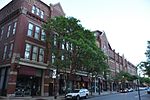Red Arrow Diner
1922 establishments in New HampshireDiners in the United StatesManchester, New HampshireRestaurants established in 1922Restaurants in New Hampshire
The Red Arrow Diner is a 24-hour diner located in the state of New Hampshire in the United States. The diner currently has four locations, in Manchester, Concord, Londonderry, Nashua, and previously had a location in Milford. Media outlets have repeatedly rated the diner one of the best in the United States, and the diner became known as a recurrent stop for politicians on the New Hampshire primary campaign trail—one of the first in the nation—during presidential primary season.
Excerpt from the Wikipedia article Red Arrow Diner (License: CC BY-SA 3.0, Authors).Red Arrow Diner
Lowell Street, Manchester
Geographical coordinates (GPS) Address Website Nearby Places Show on map
Geographical coordinates (GPS)
| Latitude | Longitude |
|---|---|
| N 42.993449 ° | E -71.4614 ° |
Address
Red Arrow Diner
Lowell Street 61
03101 Manchester
New Hampshire, United States
Open on Google Maps








